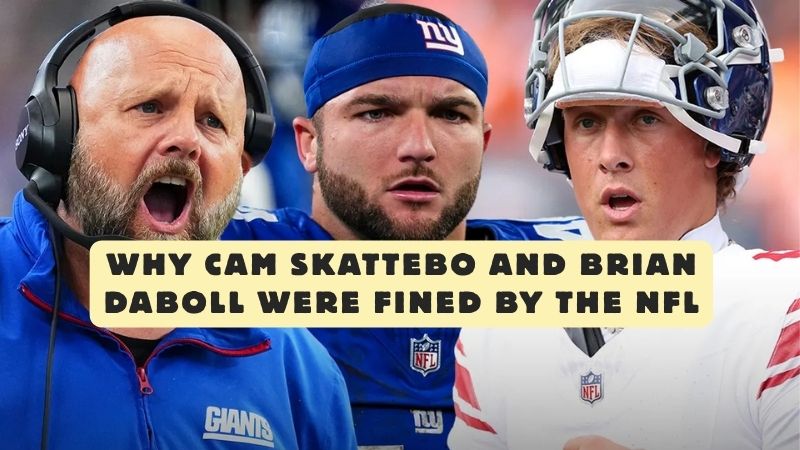What Really Happened in the Giants’ Medical Tent? Cam Skattebo and Brian Daboll NFL Fines
It was supposed to be a statement win for the New York Giants — a gritty 34–17 upset over the Philadelphia Eagles in Week 6.
But as rookie quarterback Jaxson Dart jogged off the field after taking a heavy hit from linebacker Patrick Johnson, what unfolded next would become one of the most expensive sideline moments in recent NFL memory.

Dart, clearly shaken, entered the blue medical tent, where concussion protocol evaluations take place — a strictly controlled space meant only for medical staff and league-approved evaluators. Within minutes, however, head coach Brian Daboll and running back Cam Skattebo also entered the tent, breaking a rule that has become sacrosanct in the NFL’s player safety era.
Broadcast cameras captured Daboll leaning into the tent and later visibly arguing with team orthopedist Dr. Scott A. Rodeo. The exchange, brief but emotional, raised eyebrows across the league. By the time Dart returned to finish the game — completing 17 of 25 passes for 195 yards and two touchdowns — the NFL and NFL Players Association (NFLPA) had already taken notice.
Cam Skattebo and Brian Daboll Were Fined by the NFL
Following a joint review, the NFL and NFLPA announced that the Giants organization would be fined $200,000, Daboll $100,000, and Cam Skattebo $15,000 for “conduct detrimental to the league” and violating the concussion protocol.
“When the protocol is triggered, all gameday concussion evaluations must take place either in the sideline blue medical tent or in the locker room,” the NFL and NFLPA said in a joint statement.
“Only medical personnel deemed essential to the care of the athlete may be present… No other individuals are permitted.”
While the review found that Daboll and Cam Skattebo’s actions had no actual impact on Dart’s examination or care, the league concluded that their behavior created the perception of interference — a serious issue in an era where transparency around player safety is paramount.
The fines totaled $315,000, one of the largest collective punishments ever related to concussion protocol enforcement.
Daboll’s Explanation: “I Just Wanted to Know If He Was Okay”
After the game, Daboll acknowledged his outburst and expressed regret for how it appeared on national television.
“If you’ve ever been on an NFL sideline, there’s a lot of emotion,” Daboll said. “I just wanted to know if Jaxson was okay. I wasn’t trying to interfere. I apologized directly to our team physician.”
Daboll also explained that his reaction came in the heat of the moment as the team faced a crucial fourth-down decision.
“I would have burned a timeout if he could’ve come back in,” he said. “I love our doctors. Health and safety come first — I just got emotional.”
Giants owner John Mara later said the team “fully cooperated” with the league’s investigation and immediately conducted internal training to prevent any future violations.
“Coach Daboll understands that the appearance of going to the tent is inappropriate,” Mara stated.
Cam Skattebo’s Perspective — and Second Fine
Rookie running back Cam Skattebo, who followed Dart into the tent, was fined $15,000 for entering the restricted area and another $6,157 later that week for unnecessary roughness in a separate incident against the Denver Broncos.
Cam Skattebo later told reporters his intent was never to disrupt the exam:
“I knew he was going to be fired up in there, so I went in just to calm him down. I said, ‘We’re good, man. We’ve got you.’ That’s it.”
While his actions may have come from concern, the league made clear that intent doesn’t excuse the violation.
By the end of the week, the rookie had lost over $21,000 in fines — a costly lesson early in his NFL career.
Why the Concussion Protocol Matters
The NFL’s concussion protocol has evolved dramatically over the past decade, shaped by lawsuits, research on CTE (chronic traumatic encephalopathy), and intense public scrutiny.
Under the current rules, no coach or player can be present during a medical evaluation — even for a star quarterback — to ensure that decisions are made purely on health grounds, not competitive pressure.
The blue medical tent, introduced in 2017, symbolizes this commitment to privacy and safety.
It provides a controlled environment where independent Unaffiliated Neurotrauma Consultants (UNCs) can perform examinations free from external influence.
Even the appearance of interference threatens to undermine that trust.
That’s why the league’s joint statement emphasized “the perception” of interference, not just the act itself — a crucial distinction in a league still rebuilding credibility after decades of mishandled head injuries.
Giants Caught in a New Era of Accountability
The NFL’s handling of the Giants case reflects a broader cultural shift: player safety now supersedes competitive urgency.
What might have once been dismissed as sideline intensity is now treated as a procedural breach.
The fines sent a message to all 32 franchises — no one is above protocol.
Even a well-respected head coach like Daboll, known for his fiery leadership and player relationships, was not spared.
The Giants’ quick cooperation, retraining, and public apology likely helped limit further disciplinary action.
But in the court of public opinion, the images of Daboll shouting near the medical tent were enough to spark a new round of debate about sideline boundaries.
Jaxson Dart: The Rookie in the Middle
Lost in the controversy was Jaxson Dart, the player at the center of it all.
The rookie quarterback, in only his third career start, has shown flashes of the poise that made him a first-round pick. Through four starts, Dart has completed 60.2% of his passes for 791 yards, seven touchdowns, and three interceptions, while adding 178 rushing yards and three scores.
Dart passed the concussion evaluation and returned to lead the Giants to victory, but the incident became a defining moment in his young career — a reminder that every hit, every protocol, and every decision is now under a microscope.
Zero Tolerance for Protocol Missteps
In recent years, the NFL has dealt with several high-profile concussion controversies — including the Tua Tagovailoa incident in 2022, which forced a midseason tightening of rules.
The league’s joint review committee now moves swiftly to investigate any protocol-related irregularities, no matter how minor.
By publicly fining the Giants, the NFL reasserted its “zero tolerance” stance.
While Daboll’s actions didn’t alter Dart’s medical care, the league framed the punishment as necessary to maintain integrity:
“The conduct demonstrated a disregard for the protocol’s requirements and therefore constituted a violation.”
It’s a precedent-setting message: perception equals liability.
How the Giants Responded Internally
According to team sources, the Giants responded proactively. Following the joint review, the organization instituted refresher training sessions for all sideline staff and implemented stricter access controls around the medical tent. Team security and medical coordinators were instructed to ensure that only authorized personnel are present during evaluations.
One insider told Planet News Update:
“The Giants don’t want this to happen again. It’s less about the fines and more about protecting credibility. Everyone’s now hyperaware of where they stand on that sideline.”
The Human Element
Behind the headlines, this story underscores a deeper truth about NFL culture.
Football thrives on adrenaline, urgency, and brotherhood — emotions that sometimes clash with the deliberate pace of medical caution. Daboll’s instinct to check on his quarterback wasn’t malicious; it was human.
But in today’s NFL, good intentions aren’t enough. Protocols exist because players need to be protected — sometimes even from the intensity of their own coaches and teammates.
As sports neurologist Dr. Michael Collins once told ESPN:
“The moment a player gets hit, everyone wants him back on the field. But the brain doesn’t work on a play clock.”
A League Learning from Its Past
The NFL’s concussion history is long and painful. From the days when players were sent back into games after “getting their bell rung” to billion-dollar settlements acknowledging the long-term effects of head trauma, the league’s credibility has been rebuilt through strict adherence to medical independence.
That’s why the Giants’ fine wasn’t just about one coach or one moment.
It was about the league protecting the integrity of a process it spent years reforming.
As The Athletic recently wrote, “Concussion protocol isn’t just a rulebook — it’s a symbol of the NFL’s reckoning with its past.”
Lessons Learned
As the Giants prepare for their rematch against the Eagles, the story has shifted from controversy to reflection.
Daboll remains committed to his players, Dart continues to grow as a promising young quarterback, and Cam Skattebo — fines aside — has quickly become a locker-room favorite known for his energy and accountability.
The fines will fade, but the lesson in professionalism and restraint will linger.
The NFL’s goal is clear: protecting the game begins with protecting the players — even when emotions run high.
Final Thoughts
The Giants’ Week 6 controversy may have cost them $315,000, but its impact goes beyond the financial.
It exposed how even the best-intentioned leaders can slip under the weight of the game’s urgency — and how the NFL, determined to uphold its modern safety standards, is watching every move.
For Brian Daboll and the Giants, this wasn’t just about breaking a rule. It was a reminder that in today’s NFL, every second on the sideline is part of a much larger story — one where health, perception, and integrity define the game itself.






